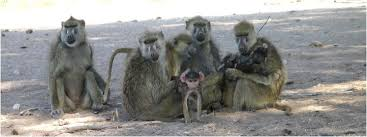Social skills of animals
- What do they understand about social status?
- Do they have language?
- Do they imitate each other?
- Do they have cultures?
- Do they have a "theory of mind"?
- Do they have morality?
_________________________
Readings
- Clive Wynne, excerpt from Can Animals Think? "Monkey see, monkey do?" (April 11)
- Dorothy Cheney & Robert Seyfarth, excerpt from Baboon Metaphysics (April 13)
- Frans De Waal, The Primate and the Philosopher (April 18, 20)
- Kristin Andrews, The Animal Mind (ch. 6-9)
Some lab science, some ethology
All engage with philosophical questions
A mix of attitudes--skeptical, open, eager
_________________________What do animals know about each others' social status?
Dorothy Cheney and Robert Seyfarth, "The Evolution of Language from Social Cognition"
Kristin Andrews, The Animal Mind chapter 5 (p. 111-112)
- matrilineal social structure studied first
- violation of expectation study using hidden speakers
- grunts are aggressive, screams are submissive
- hidden speaker plays
- B4 GRUNTS, C9 SCREAMS (no surprise reaction)
- C9 GRUNTS, B4 SCREAMS (surprise reaction)
- Cheney and Seyfarth argue: the baboons have "propositional attitudes"
- They believe that B4 is threatening C9
- They are surprised that C9 is threatening B4
- These structured thoughts are in a language of thought
- alternative: could they have a diagram-like representation?
- These thoughts probably aren't conscious
- These thoughts are precursors of language
_________________________
Are the baboon vocalizations language?
Baboons have 10-20 screams and grunts, including the WAHOO
Vervet alarm calls
But is it language?
- Human language is compositional -- syntax and semantics -- "The cat is on the mat."
- Human language is "productive" -- you can produce and comprehend an unlimited number of sentences
- Communicative intentions -- you say "pass the salt" with intentions about the hearer's beliefs -- this involves you having "theory of mind"
- Do animals have enough "theory of mind" to have communicative intentions?
- More about this in next reading
Animal communication
Definition. "any act of structure which alters the behaviors of other organisms, which evolved because of that effect, and which is effective because the receiver's response has also evolved." (Andrews p. 139)flanges "communicate" dominance
(some males don't have them)- This definition covers vocalizations but also displays and anatomical parts
_________________________
Teaching animals human languages
- Can it be done?
- If so, what does that show?
Snow days -- make-up content
- Project Nim
- Noam Chomsky discussing Project Nim
- Irene Pepperberg discussing teaching language to Alex (a parrot)
- Kristin Andrews, The Animal Mind chapter 5
Imitation, learning, and culture
Reading, Clive Wynne, Can Animals Think? -- "Monkey See, Monkey Do?"
- apprentice imitates the master
- easy?
- Potato washing macaque monkeys on Japanese island of Koshima (Imo, 1953)
Wynne: must consider alternative hypotheses
- What are the alternative hypotheses?
- Must show that imitation is the best of all the hypotheses
- Associative learning--
- learning by associating "two objects, properties, or events" (Andrews glossary, p. 261)
- Salt and pepper, lightening and thunder, first half of scale, second half
- dogs: Leash and walk
- low level, very common ability
- Imitation, similar to contagious yawning
- Imitation for the sake of a perceived benefit
Is he really saying animals never imitate?
Are the Koshima monkeys a distinct macaque culture?
- What is culture? different subgroups of same species have different practice
- Is this a good all-purpose definition?
_________________________
Theory of Mind
Reading--Clive Wynne, Can Animals Think? "Monkey see, monkey do?"
Next time--Cheney and Seyfarth, chapter from Baboon Metaphysics
What's the question?
- Do animals have a "theory" of mind? (theory, because mental states aren't observed).
- Are animals mindreaders?
- Do animals attribute purposes, intentions, perceptions, emotions, beliefs, desires, to others?
Irresistible to think they do. Cats and dogs look at us when they want food, or to go outside. Surely they know we have minds and they're trying to change our minds!
Theory of mind research
- about children
- about animals, starting with Premack and Woodruff, 1978
_________________________
Premack and Woodruff experiment (1978)
Sarah (chimp) watches video of human trying to solve problem, must choose solution from several options
 |
| Trying to reach bananas .... stand on box is solution |
 |
| Trying to get out of locked cage.....key is solution |
 |
| Trying to play a record ..... plugging it in is the solution |
Premack and Woodruff discuss rival hypotheses:
- Associative learning -- no, because problems haven't been seen before
- Empathy ("this is what I would do") .... no, because these aren't my problems
- Mindreading/theory of mind ... yes, Sarah understands the actor's purposes
Wynne writes this off -- he focuses only on version #1 and seems to think the solution photo shows someone eating a banana, but it doesn't!
Another hypothesis--
- Behavior reading
_________________________
A different paradigm: the false belief task
Example of how it can be posed to animals






No comments:
Post a Comment